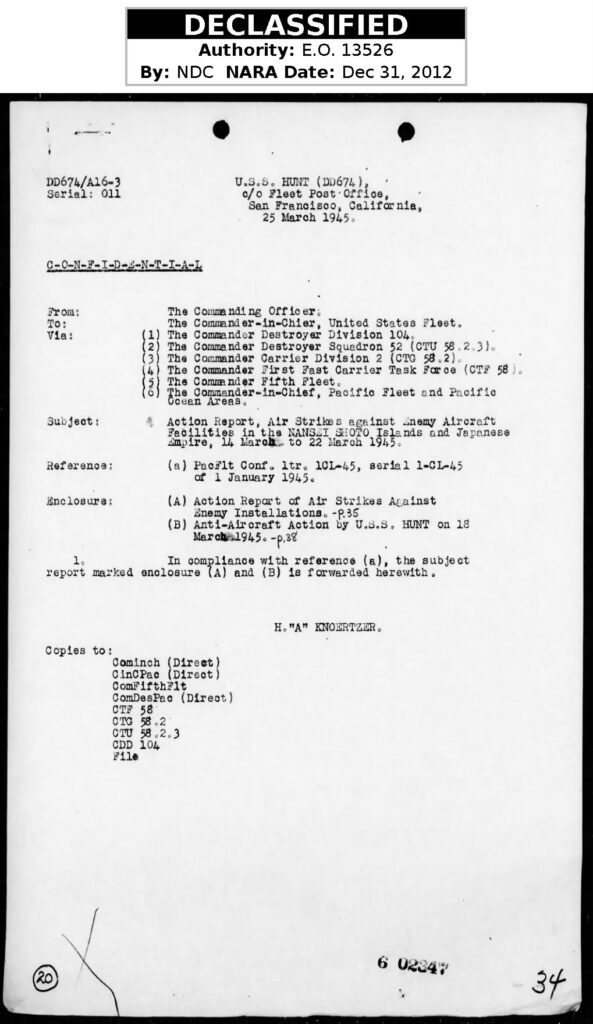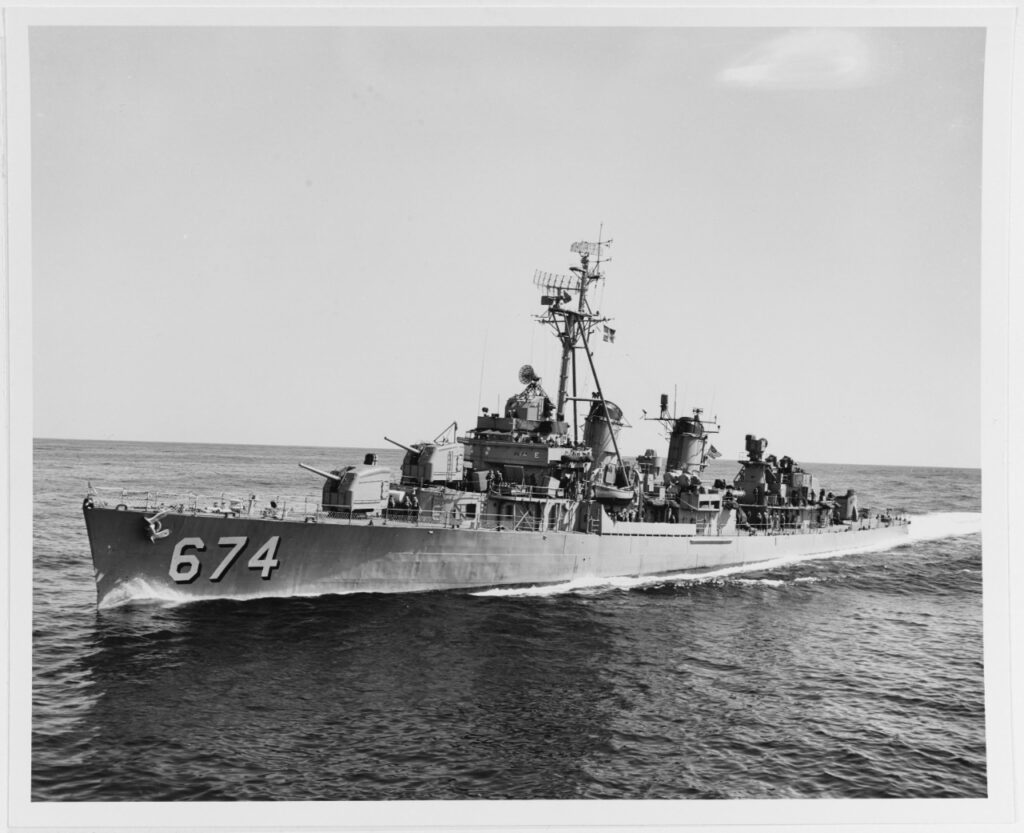USS HUNT Action Report-Aiding USS Franklin

In my research into the events of 19 March 1945 aboard the USS FRANKLIN, I have been reading various primary sources, such as deck logs, war diaries, and action reports. I am especially fascinated by the action reports of the different ship and task force commanders. (You can learn more about the purpose of an action report by reading my earlier post, How Action Reports Helped The US Navy Defeat The Japanese.)
Action Reports don’t just recount the action; they’re also a place for the authors to provide feedback to higher-ups. These come in the form of “Lessons Learned, Conclusions, and Recommendations,” published at the end of the report. I’ve just recently finished reading the action report of one of the destroyers that came to FRANKLIN’s aid when she was attacked.
On 14 March 1945, USS HUNT (DD 674), a FLETCHER-class destroyer, departed Ulithi Atoll. She was one of 27 ships, carriers, battleships, and destroyers assigned to Task Group 58.2.* Her task group was one of four that made up Task Force 58. Their mission was to prevent Japanese air and naval forces from opposing the invasion of Okinawa, scheduled for 1 April.
Striking Japan
Task Force 58 arrived off the coast of southern Japan on the night of 17-18 March. Before dawn, at 0450, HUNT went to General Quarters to repel the first of many air attacks. Ten minutes later, the carriers in her task group, FRANKLIN, HANCOCK, SAN JACINTO, AND BATAAN, began launching airstrikes against targets on the Japanese island of Kyushu.
She secured from General Quarters at 0925 after firing on a Japanese aircraft that had attacked a nearby task group. She would go to General Quarters three more times before midnight.
19 March “Bomb Day”**
The carriers launched their first aircraft before dawn. At 0707, HUNT went to General Quarters to repel air attacks, and at about the same time, a Japanese bomber attacked FRANKLIN. Her action report states:
0707 USS FRANKLIN hit by enemy aircraft bomb and commenced burning furiously. Closed USS FRANKLIN to render assistance and picked up survivors who were blown overboard or had abandoned ship.
0723 USS FRANKLIN burning from her bridge island structure to her fantail exploded amidships with large fires followed by intermittent explosions with men abandoning ship to starboard; this vessel stopped to lower life boats and recover personnel in the water and on rafts.
By 1348, HUNT had secured from General Quarters and had completed rescue operations. She picked up 429 survivors.
At 1420, she sounded General Quarters to repel an air attack. By this time, FRANKLIN was under tow by the heavy cruiser USS PITTSBURGH. HUNT proceeded to patrol counter-clockwise around the two ships.
HUNT would escort Franklin and other damaged ships to Ulithi, conducting burial operations for three men from FRANKLIN.
This group of wounded ships and their escorts designated TU 58.2.9, arrived at Ulithi Atoll on 24 March, having fought off several more air attacks.
Action Report “Lessons Learned, Conclusions, and Recommendations”

The report discusses many lessons learned and makes several recommendations. The ones I found most interesting dealt with the crew’s handling of the men they picked up from FRANKLIN.
According to the USS PITTSBURGH’s deck log for 19 March, the water temperature was 67 degrees. One of the lessons learned stated in HUNT’s Action Report was that men who had spent time in water
do not as a rule realize how badly injured they are. One man was assisted up the cargo net and as he came on deck took three steps. His second step was noticed when we heard a crack and looked down to discover him walking on a badly broken ankle with apparently no pain. Later it was learned the man had second degree burns on his hands and serious shrapnel wounds in his back, one of which punctured a lung. The water and cold air had apparently prevented bleeding.
March weather off Japan’s coast is chilly, and the water is cold, as mentioned. The report states that men who appeared uninjured were taken below decks, wrapped in blankets, and placed in bunks to warm up. A “surgery” had been set up in the ship’s wardroom, and badly injured men were sent there. As volunteers from the survivors felt well enough to return topside, they were sent down to the engineering spaces to keep warm, as many lacked proper clothing. This also kept them out of the crew’s way.
During the spring of 1945, HUNT would continue to go in harm’s way, fighting off Kamikaze attacks and serving in the dangerous role of picket duty during the Battle of Okinawa.
According to the website Haze Gray and Underway, she was decommissioned in December 1945 but recommissioned in 1951. She served honorably through the 1950s and earned the Battle Efficiency Award two years running, 1957-1958. She was decommissioned in 1963.
*Unless otherwise indicated, sources for this are from “Action Report, Capture IWO Jima and Concurrent Carrier Strikes on TOKYO and OKINAWA, JANUARY-MARCH 1945,” dated 2 April 1945. US National Archives, via Fold3.com. Accessed 15 August 2024.
**”Bomb Day” is how FRANKLIN’s crew came to refer to the events of 19 March.
Did you arrive here via a search engine? I am the author of the forthcoming book Heroes By The Hundreds: The Story of the USS Franklin (CV-13). In addition to writing about the bravery of the crews that saved her, I will discuss the lessons we can learn in leadership and decision-making and the changes the US Navy made because of those lessons.
Feel free to follow me on Facebook. There, I am M. Glenn Ross, Author. I also write a monthly newsletter, Glenn’s Action Report, about subjects I find interesting in my research. You can sign up for it below. Feel free to leave a comment or ask a question. Thanks for reading.
-Glenn